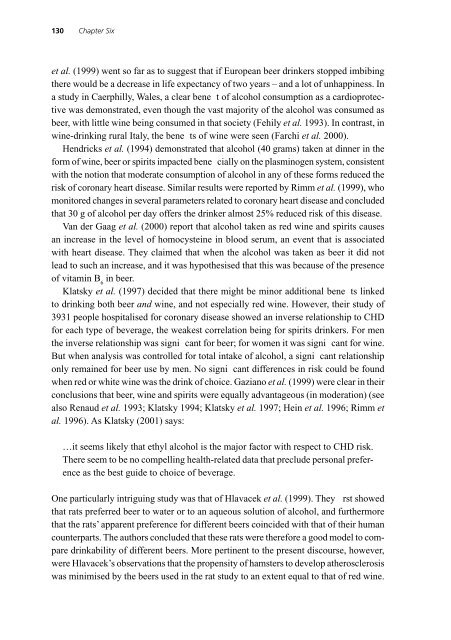Beer : Health and Nutrition
Beer : Health and Nutrition
Beer : Health and Nutrition
Create successful ePaper yourself
Turn your PDF publications into a flip-book with our unique Google optimized e-Paper software.
130 Chapter Six<br />
et al. (1999) went so far as to suggest that if European beer drinkers stopped imbibing<br />
there would be a decrease in life expectancy of two years – <strong>and</strong> a lot of unhappiness. In<br />
a study in Caerphilly, Wales, a clear bene t of alcohol consumption as a cardioprotective<br />
was demonstrated, even though the vast majority of the alcohol was consumed as<br />
beer, with little wine being consumed in that society (Fehily et al. 1993). In contrast, in<br />
wine-drinking rural Italy, the bene ts of wine were seen (Farchi et al. 2000).<br />
Hendricks et al. (1994) demonstrated that alcohol (40 grams) taken at dinner in the<br />
form of wine, beer or spirits impacted bene cially on the plasminogen system, consistent<br />
with the notion that moderate consumption of alcohol in any of these forms reduced the<br />
risk of coronary heart disease. Similar results were reported by Rimm et al. (1999), who<br />
monitored changes in several parameters related to coronary heart disease <strong>and</strong> concluded<br />
that 30 g of alcohol per day offers the drinker almost 25% reduced risk of this disease.<br />
Van der Gaag et al. (2000) report that alcohol taken as red wine <strong>and</strong> spirits causes<br />
an increase in the level of homocysteine in blood serum, an event that is associated<br />
with heart disease. They claimed that when the alcohol was taken as beer it did not<br />
lead to such an increase, <strong>and</strong> it was hypothesised that this was because of the presence<br />
of vitamin B 6 in beer.<br />
Klatsky et al. (1997) decided that there might be minor additional bene ts linked<br />
to drinking both beer <strong>and</strong> wine, <strong>and</strong> not especially red wine. However, their study of<br />
3931 people hospitalised for coronary disease showed an inverse relationship to CHD<br />
for each type of beverage, the weakest correlation being for spirits drinkers. For men<br />
the inverse relationship was signi cant for beer; for women it was signi cant for wine.<br />
But when analysis was controlled for total intake of alcohol, a signi cant relationship<br />
only remained for beer use by men. No signi cant differences in risk could be found<br />
when red or white wine was the drink of choice. Gaziano et al. (1999) were clear in their<br />
conclusions that beer, wine <strong>and</strong> spirits were equally advantageous (in moderation) (see<br />
also Renaud et al. 1993; Klatsky 1994; Klatsky et al. 1997; Hein et al. 1996; Rimm et<br />
al. 1996). As Klatsky (2001) says:<br />
…it seems likely that ethyl alcohol is the major factor with respect to CHD risk.<br />
There seem to be no compelling health-related data that preclude personal preference<br />
as the best guide to choice of beverage.<br />
One particularly intriguing study was that of Hlavacek et al. (1999). They rst showed<br />
that rats preferred beer to water or to an aqueous solution of alcohol, <strong>and</strong> furthermore<br />
that the rats’ apparent preference for different beers coincided with that of their human<br />
counterparts. The authors concluded that these rats were therefore a good model to compare<br />
drinkability of different beers. More pertinent to the present discourse, however,<br />
were Hlavacek’s observations that the propensity of hamsters to develop atherosclerosis<br />
was minimised by the beers used in the rat study to an extent equal to that of red wine.

















